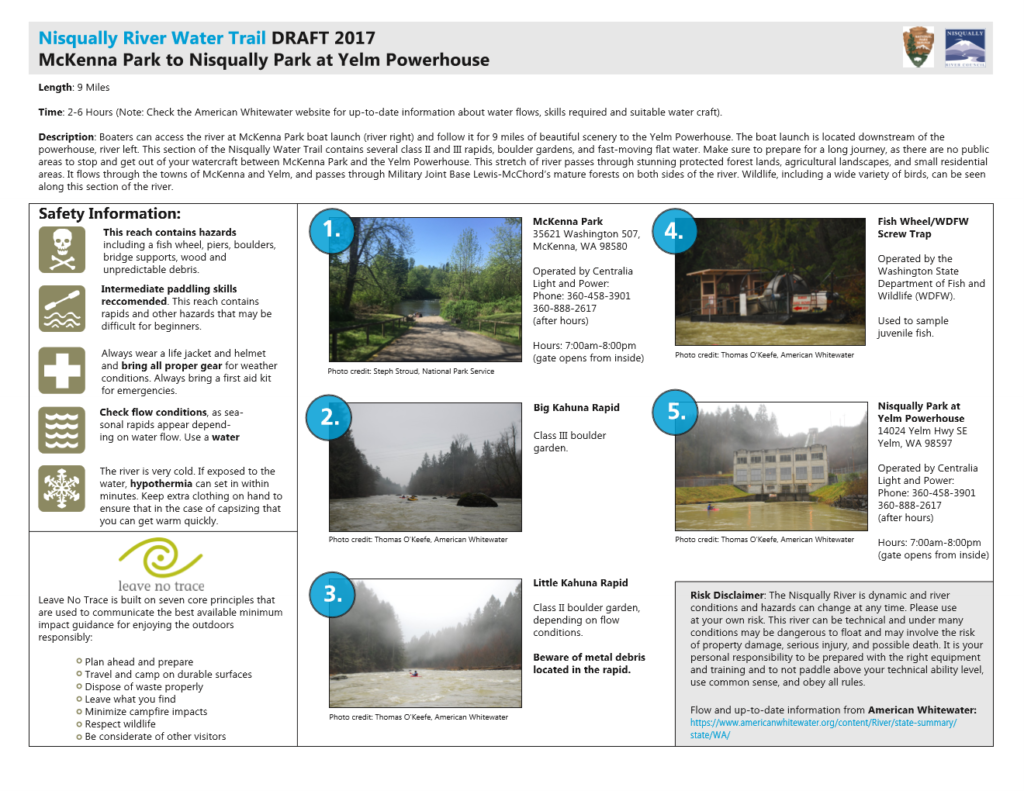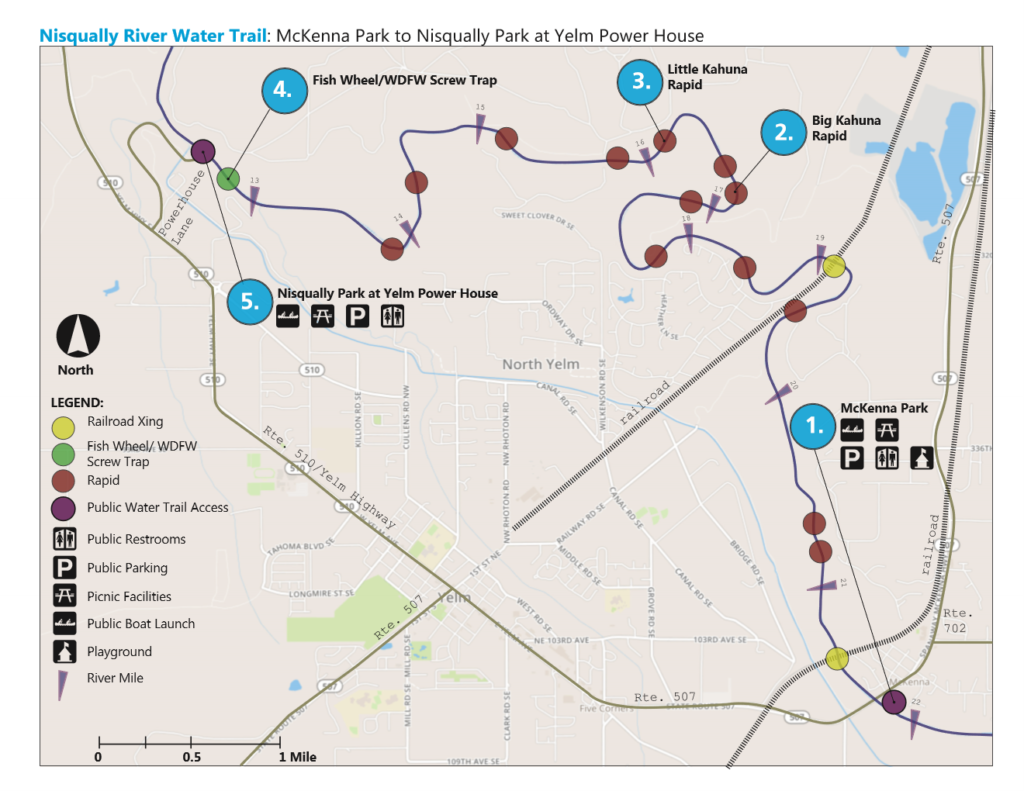- This reach contains hazards
- Intermediate paddling skills are recommended
- Always wear a life jacket and helmet and carry a first aid kit
- Check flow conditions
- The water is very cold and hypothermia can set in within minutes
The McKenna Park to Nisqually Park at Yelm Powerhouse is currently the uppermost developed reach of the Nisqually River. It features class II and III rapids, boulder gardens, and fast-moving water. It is an easy drive from I-5, and provides close-to-home experiences for local boaters. The river flows through small housing developments, agricultural areas, Joint Base Lewis-McChord, the towns of McKenna and Yelm, and conservation lands. It is approximately 9 miles in length and can take 2-6 hours to float depending on river flow, experience level, water craft used and other factors.
Boaters can access the river at McKenna Park boat launch (river right) and follow it to the Yelm Powerhouse. The boat launch is located just downstream of the powerhouse, on river left. Make sure to prepare for a long journey, as there are no public areas to stop and get out of your watercraft between McKenna Park and the Yelm Powerhouse.
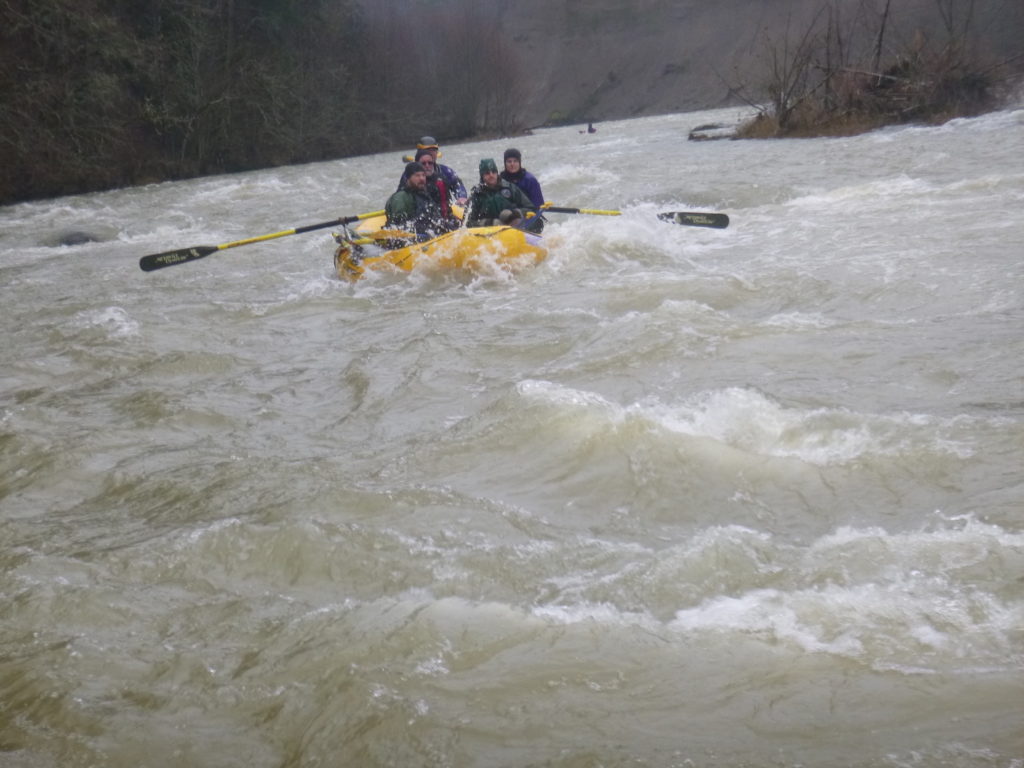
The McKenna Park – Nisqually Park at Yelm Powerhouse river reach features whitewater rapids. Photo: Thomas O’Keefe
Put-in at McKenna Park (river right, approx. River Mile 22), which is owned and operated by the City of Centralia.
Address: 35621 Washington 507, McKenna WA, 98580
Contact: 360-458-3901 or 360-888-2617 (after hours)
Hours: 7:00 am – 8:00 pm. Note – hours are subject to change. Be sure to contact the City of Centralia for most up-to-date information.
- The put-in is a paved boat launch. Plenty of parking is available on site, as are restrooms, picnic tables and a playground.
- This access site is heavily used in the summer by a variety of users including fishermen, innertubers and other boaters. Be ready to share!
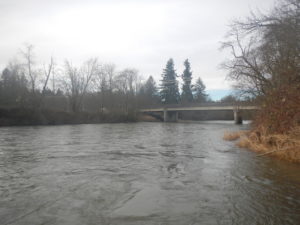
Looking downstream from the McKenna put-in
Take-out at Nisqually Park at Yelm Powerhouse, on river left (approx. River Mile 12.5). It is owned and operated by the City of Centralia.
Address: 14024 Yelm Hwy SE, Yelm WA 98597
Contact: 360-458-3901 or 360-888-2617 (after hours)
Hours: 7:00 am – 8:00 pm. Note – hours are subject to change. Contact the City of Centralia for most up-to-date information.
- The take-out has a paved boat launch, well maintained portable toilets, a picnic area and a parking lot.
- The access site is well used during the summer months, especially May-August.
Flow Information
The City of Centralia operates a hydroelectric dam just upstream of McKenna Park. At this dam, water is taken out of the Nisqually River and transported through a canal before re-entering the Nisqually River at the Yelm Powerhouse. This section of river may experience lower flows than the rest of the Nisqually River. During times of low flow–especially during summer months–this section of river can be too low to run in certain water craft – keep an eye on American Whitewater’s flow gauges for current information.
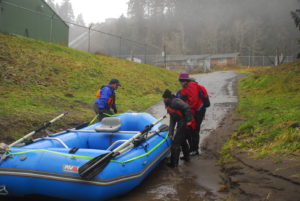
Nisqually Park boat launch. Photo: Thomas O’Keefe
Hazards & Safety Consideration
*Note: this list is not exhaustive! River conditions can change rapidly, and new hazards may appear at any time.
- Before going on any river, be sure to take steps to increase personal responsibility, boat safety, the preparedness of your group and to understand water rescue principles. American Whitewater has a comprehensive list of actions that all river users should take to increase their safety. Make sure you and everyone in your boating party follows these guidelines!
- Always wear a life jacket and helmet and bring all proper gear for weather conditions. Always bring a first aid kit for emergencies.
- The Nisqually River has cold and swift water, poor water visibility, log jams, boulder gardens, and other natural hazards that can change at any moment. These hazards can quickly turn lethal if users are unprepared. Among other things, hypothermia can set in within minutes when exposed to the water.
- The stretch of river has hazards, including but not limited to a fish trap, wood, whitewater rapids, and unpredictable debris. American Whitewater’s website includes river miles, pictures, and user-submitted information about each named rapid; be sure to check for the most recent information prior to launching your boat.
- Intermediate paddling skills are recommended along this reach. The reach contains rapids and other hazards that may be difficult for beginners.
- The Washington Department of Fish and Wildlife (WDFW) operates a Screw Trap approximately 1/4 mile upstream of the Yelm Powerhouse facility. A sign is located upstream to warn boaters of the approaching hazard. It is easily avoided provided boaters are able to maneuver his/her craft.
- On this stretch of river, boaters must pass under several bridges and/or railroad trestles. The piers and abutments in the river pose a significant hazard to users. Depending on river flows and past flooding, these abutments can collect logs, uprooted trees, branches and other debris at their base, often directly in the main current of the river. These obstacles can be fatal if users are unable to maneuver around them.
- Check flow conditions, as seasonal rapids appear depending on water flow. Beware of hazards in the water such as log jams and boulders. Note: this stretch of river is subject to lower flows than the surrounding reaches. Be sure flows are within a safe level prior to boating.
Map
This map and guide is available for print from this website. Download a PDF version to print here. Please note that this map is only a rough guideline of known hazards, and water conditions can change at any time. You are responsible for your own safety.
Leave No Trace
Leave No Trace is built on seven core principles that are used to communicate the best available minimum impact guidance for enjoying the outdoors responsibly:
- Plan ahead and prepare
- Travel and camp on durable surfaces
- Dispose of waste properly
- Leave what you find
- Minimize campfire impacts
- Respect wildlife
- Be considerate of other visitors
Please help us keep the Nisqually Watershed beautiful and healthy by practicing these principles whenever you go outside!
Risk Disclaimer
The Nisqually River is dynamic and river conditions and hazards can change at any time. Please use at your own risk. This river can be technical and under many conditions may be dangerous to float and may involved the risk of property damage, serious injury, and possible death. It is your personal responsibility to be prepared with the right equipment and training and to not paddle above your technical ability level, use common sense, and obey all rules.





